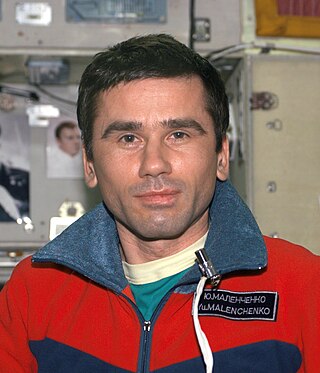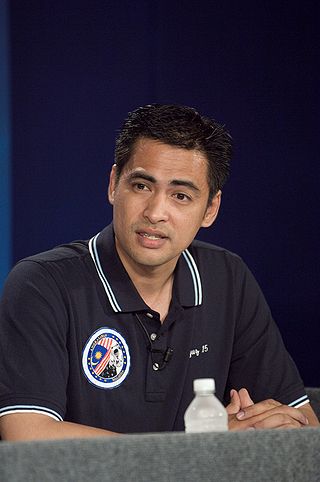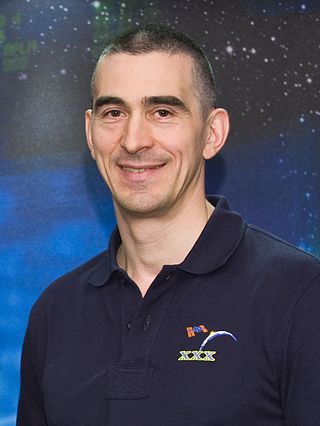
Yuri Ivanovich Malenchenko is a retired Russian cosmonaut. Malenchenko became the first person to marry in space, on 10 August 2003, when he married Ekaterina Dmitrieva, who was in Texas, while he was 240 miles (390 km) over New Zealand, on the International Space Station. As of December 2023, Malenchenko ranks third for career time in space due to his time on both Mir and the International Space Station (ISS). He is a former commander of the International Space Station.

Yury Valentinovich Lonchakov is a Russian former cosmonaut and a veteran of three space missions. He has spent 200 days in space and has conducted two spacewalks. From 2014 to 2017, Lonchakov served as head of the Yuri Gagarin Cosmonaut Training Center.

Frank, Viscount De Winne is a Belgian Air Component officer and an ESA astronaut. He is Belgium's second person in space. He was the first ESA astronaut to command a space mission when he served as commander of ISS Expedition 21. ESA astronaut de Winne serves currently as Head of the European Astronaut Centre of the European Space Agency in Cologne/Germany (Köln).

Fyodor Nikolayevich Yurchikhin is a Russian cosmonaut of Pontic Greek descent, engineer and RSC Energia test-pilot who has flown on five spaceflights. His first spaceflight was a 10-day Space Shuttle mission STS-112. His second was a long-duration stay aboard the International Space Station (ISS) as a flight engineer for Expedition 15; for this mission he was launched in the Soyuz TMA-10 spacecraft. He has undertaken two further long-duration stays aboard the ISS, as a crew member of Expedition 24 / 25. For this mission he was launched with the spacecraft Soyuz TMA-19, and he landed in November 2010, also with the Soyuz TMA-19 spacecraft. He served as Soyuz commander for his fourth mission aboard Soyuz TMA-09M, as flight engineer for Expedition 36 and ISS commander for Expedition 37. In April 2017, Yurchikhin launched on Soyuz MS-04 for the fifth spaceflight of his career, a six-month mission to the ISS as part of Expedition 51 and 52, for which he was the commander.

Soyuz TMA-11 was a human spaceflight mission using a Soyuz-TMA spacecraft to transport personnel to and from the International Space Station (ISS). The mission began at 13:22 UTC on October 10, 2007, when the spacecraft was launched from the Baikonur Cosmodrome by a Soyuz FG launch vehicle. It brought to the station two members of the ISS Expedition 16 crew, as well as Sheikh Muszaphar, the first Malaysian in space. TMA-11 remained at the station as an escape craft, and returned safely to Earth on April 19, 2008, after it had been replaced by Soyuz TMA-12. Although the vehicle landed safely, it suffered a partial separation failure which caused a ballistic re-entry that in turn caused it to land 475 km from the intended landing point.

Jamaluddin bin Mohd Jarjis was a Malaysian politician, diplomat and Minister of Science, Technology and Innovation. He served as the Chairman of the 1 Malaysia Peoples' Housing (PR1MA) and Malaysian special envoy to the United States.

The National Space Agency, abbreviated ANGKASA, was the national space agency of Malaysia. It was established in 2002 and its charter aims to upgrade, stimulate and foster the country's space programme through integrated and coordinated efforts by developing and applying space technologies.

This article lists important figures and events in Malaysian public affairs during the year 2007, together with births and deaths of notable Malaysians. 2007 marked 50 years of Malaysian independence.

Sheikh Muszaphar Shukor Al Masrie bin Sheikh Mustapha is a Malaysian orthopaedic surgeon and spaceflight participant. He launched to the International Space Station aboard Soyuz TMA-11 with the Expedition 16 crew on 10 October 2007. Sheikh Muszaphar flew under an agreement with Russia through the Angkasawan program, and returned to Earth on 21 October 2007, aboard Soyuz TMA-10 with the Expedition 15 crew members, Fyodor Yurchikhin and Oleg Kotov.

Satoshi Furukawa is a Japanese surgeon and JAXA astronaut. Furukawa was assigned to the International Space Station as a flight engineer on long-duration missions Expedition 28/29 (2011) and Expedition 69/70 (2023-2024).

Akihiko Hoshide is a Japanese engineer, JAXA astronaut, and former commander of the International Space Station. On August 30, 2012, Hoshide became the third Japanese astronaut to walk in space.

Faiz bin Khaleed is a Malaysian military dentist with the Malaysian Armed Forces. In September 2006, he was selected as one of two final candidates to undergo astronaut training in Star City as part of the Angkasawan program. The other candidate was Sheikh Muszaphar Shukor.

Sergey Aleksandrovich Volkov is a retired Russian cosmonaut and engineer. He was a member of three missions to the International Space Station, spending more than a year in total in space. During his missions he did four spacewalks lasting more than 23 hours in total. Volkov retired from the Cosmonaut group in February 2017.
Spaceflight participant is the term used by NASA, Roscosmos, and the Federal Aviation Administration (FAA) for people who travel into space, but are not professional astronauts.

Malaysia–Russia relations are the bilateral foreign relations between the two countries, Malaysia and Russia. Russia has an embassy in Kuala Lumpur, and Malaysia has an embassy in Moscow.

Aleksandr Mikhailovich Samokutyaev is a Russian politician and former cosmonaut. Samokutyaev served as a Flight Engineer for the International Space Station (ISS) long duration Expedition 27/28 missions. He also served as the Soyuz TMA-21 commander. He most recently served on the Soyuz TMA-14M Expedition 41/42 crew aboard the ISS. He was hired as a cosmonaut in the summer of 2003.

Anatoli Alekseyevich Ivanishin is a former Russian cosmonaut. His first visit to space was to the International Space Station on board the Soyuz TMA-22 spacecraft as an Expedition 29/Expedition 30 crew member, launching in November 2011 and returning in April 2012. Ivanishin was the commander of the International Space Station for Expedition 49.

Science policy in Malaysia is regulated by the Ministry of Science, Technology, and Innovation. The ministry focuses on five areas: biotechnology, ICT policy, industry, sea to space and core science and technology. Other ministries, such as the Ministry of Agriculture and the Ministry of Health also have science departments. Training in scientific areas was promoted during the 1970s and 1980s. From 1987 to 1997 research and development used 0.24% of GNP, and in 1998 high-tech exports made up 54% of Malaysia's manufactured exports.
Siva Vanajah is a Malaysian engineer and one of the finalist of the Malaysian Angkasawan program, a program to send a Malaysian to the International Space Station. An ethnic Indian, she was the only woman among four finalists who outlasted 11,000 other Malaysians that applied for the astronaut selection process in 2003, ultimately losing her bid to Sheikh Muszaphar Shukor and Faiz Khaleed. All the four finalists were sent to Moscow for training by the Russian Space Agency.

















